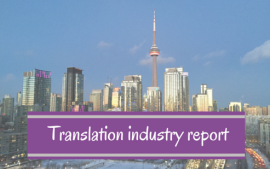
In 2012, the Government of Canada’s Translation Bureau commissioned PricewaterhouseCoopers to conduct a benchmarking and comparative analysis. This study obtained feedback from clients, the translation industry and the Canadian public to provide information on the Canadian industry’s capacity to meet national and government demand for translation. It also touched on benchmarks for good practices in linguistic services.
The analysis includes information related to challenges and emerging trends in the translation industry.
Title: Translation Bureau Benchmarking and Comparative Analysis
Date: May 15, 2012
The language services industry is a global concern, with over 25,000 Language Service Providers (LSPs) in 152 countries.
The translation industry is spread out over the following countries, each with more than 500 LSPs: Canada, the United States, Western and Northern Europe, China, India and Japan. The market is highly fragmented, with the top 50 LSPs generating US$4 billion of the US$31 billion market.
63.4% of LSPs expect to remain independent and grow organically. While 18% of LSPs would like to make one or more acquisitions in the near or mid-term, 50.9% are open to business combinations (mergers and acquisitions) that would consolidate them in the marketplace. The LSP market is growing at an annual rate of 7.41%. The Translation Software market is anticipated to reach US$3 billion by 2017.
Most LSPs get 70% or more of their revenue from translation services. A number of other LSPs generate less than 10% of their revenue from services other than translation. Software localization (21.4% of LSPs), website globalization (15.5% of LSPs), on-site interpreting (27.9% of LSPs) and multimedia localization (9.1% of LSPs) account for other service areas at LSPs generating more than 10% of their revenue from a service that is not translation. The fastest growing services, in descending order, are:
- translation;
- website globalization
- software localization
- on-site interpreting
- multimedia localization
Internationally, the majority of LSPs have small employee bases:
- 69.3% have 1-5 employees
- 92.4% have 1-20 employees
- 0.6% have more than 100 full-time employees.
Approximately 57% of LSPs have been in business for five years or less, while only 6.4% have more than 20 years of experience. Many LSPs are micro-enterprises with 78.4% run by their founding owner.
Canada-specific data
Canada is a leader in the translation market. With only 0.5% of the global population, it represents approximately 10% of the US$31 billion global market. This reflects Canada’s official language status. Approximately 90% of translation in Canada is between French and English.
In the public sector, the Canadian Government is by far the largest employer with 71% of the public sector translation workforce. Almost half of the Canadian workforce is concentrated in Quebec (49%) and almost a third in Ontario (31%).
Canada’s rising diversity is increasing the demand for languages other than French and English. Both globally and in the Canadian market, demand for less common languages is mounting and will continue to drive growth.
Based on data from 2010-2011, the Canadian Translation Bureau’s productivity ratio was approximately 250 words/hour. This is on the lower-middle end of the scale as compared to the organizations interviewed that ranged from 195–333 words/hour.
Interesting findings
Many organizations that were interviewed for the survey stated that technolinguistic tool use was optional and at the translator’s discretion. This is mainly because of cultural resistance by translation professionals to use these tools. They are seen as further automating and commodifying a service that language professionals generally see as a creative exercise.
Quality assurance often relies on the translator’s skill, rather than being a separate function within the process. With some exceptions (certified or legal documents), quality is not considered as important to clients as cost or speed. More importantly, quality is expected by clients and therefore not considered a differentiator.
Header image credit: Unsplash
Header image edited with Canva








Hi Catherine,
Thanks for the great summary! Some really interesting insights. Good to see that the growth rate stays strong, my bet that this number will only keep growing. It’s an amazing industry to be in right now. A very interesting point about quality that our clients treat it as a given. Too bad it’s not always a reality and many clients end up with poorly translated websites and documents because they choose based on cost or rush their translations and localization to the point where there is no time for proofreading. I think we need to educate our clients about the importance of quality and that it comes at a price. Thanks again for sharing and have a lovely day!
Thank you for your comment Dmitry! You’re right, client education (subtly) never stops. It’s not that clients don’t care for quality, it’s that in most cases speed and price are higher priorities. Translators use quality as a differentiator sometimes to convince clients that a higher rate is worth it, but we should try and ‘serve’ it better, i.e. not say “work with us and not XXX because they are bottom-feeders, they don’t treat their translators with respect” etc. but focus on our background and achievements and why/how those will contribute to offering a premium service which in turn will lead to more customers/money and so on for our (potential) clients.
In other words: “show them value” 🙂